How To Build a Raised Planter Box

Note: All projects performed following instructions found on this site are done at your own risk. Learn more
The construction of this raised planter box is quite simple. It has a style that suits your farmhouse or the village you live in. In terms of durability, the screws we will use will overcome this.
Building a raised planter can be both fun and budget friendly. Read on for the plans and steps for how to make a raised planter.
You will raised planter plans, dimensions, details, instructions here. Review them carefully so you will be ready when it’s time to cut and organize the pieces.
Raised planter box building process starts from legs and side supports. Hardwood or pressure-treated boards are a popular choice, as are cedar and cypress.
Pressure-treated timber is easy to stain, durable and budget-friendly.
1) Starts by checking the list of tools to use for your DIY raised planter box. After collecting the missing tools, focus on purchasing materials.
2) Measure and cut all the pieces and prepare them. Measure the length twice before doing your cuts. Make sure to label each one.
Tips: Drill pilot holes in wood pieces using a power drill for easy connections. 3) Follow the Project details for assemble the wood pieces.
4) We will use three screws. 2 ½’’, 3" and 5" Screw.
5) You will secure use wood glue to the contact surface.
6) Fill any gaps and frame nail holes with wood putty.
7) Sand the entire Project with 150-220 grit or more sandpaper and dust pf prior to painting or staining your finished Project.

Cut List:
A1 - 4 – 4 x 4 x 26″ 8' 8'' legs
B1 - 8 – 2 x 6 x 22″ 14' 8'' right and left supports
C1 - 8 – 2 x 6 x 54″ 36' front and back supports
D1 - 4 – 2 x 6 x 54″ 18' bottom supports
E1 - 2 - 2 x 4 x 22″ 3' 8'' right and left parts of the top parts
F1 - 2 - 2 x 4 x 61″ 10' 2'' upper part front and back
Total: 2x4x13' 10'' , 2x6x68' 8'' , 4x4x8' 8''
List of tools:
- Tape measure
- Saw
- Drill
- Countersink drill bit
- Wood glue
- 2 1/2", 3" and 5" Screw.
- Sanding
Stain/preferred paint coating:
- Water-Based Pre-Stain Wood Conditioner
- Water-Based Wood Stain mixed: Desert Sand and Pure White
- Water-Based polycrylic
Note: As an Amazon Associate, I earn from qualifying purchases.

Side View:

Front View:

Top View:
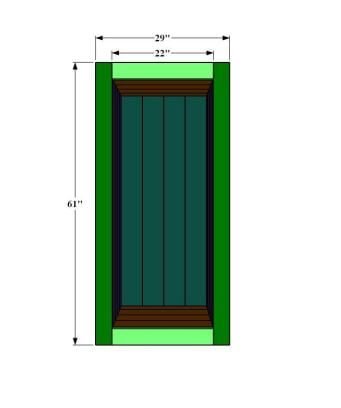
Bottom View:

Assambly Process:
Step 1:
We measure and mark a distance of 16 inches from the bottom of our A1(4 x 4 x 38'') feet to the top.
Here, the B1 piece will be placed on the innermost part of the A1 foot. A distance of 2'' will remain outward.
Then we place our B1(2 x 6 x 22'') side support on the marked place and we stick it firmly and drill and screw our screw holes.
Then we glue the other A1 leg in the same way and screw it on the outer side using a 5 inch screw. I find 5'' screw suitable for it to be more robust.
While screwing, our screw needs to come to the middle of part B1.
Because in the next stages, we will screw in 2 places, the bottom and the top, while screwing the side support parts.
Then we do the same operations for the legs on the opposite side.

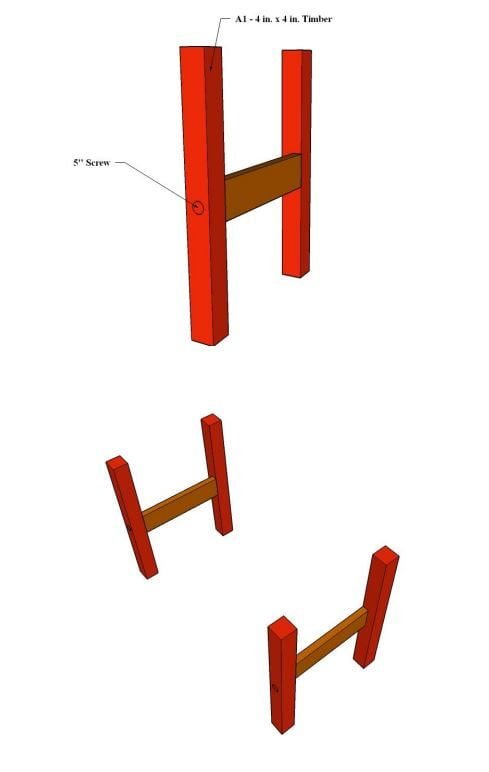
Step 2:
Here we mark and assemble our C1 (2 x 6 x 54'') front support piece by measuring 16 inches upwards under our A1 leg.
We do the screwing process 2 pieces, up and down, from the back side of our A1 and A2 feet. It will be better if you use a 5 inch screw to hold the weight of the soil.
This is to be more robust. We screwed the B1 piece from the middle part, it will not touch the screws here.

Step 3:
Now, we stick the opposite feet, which we repeated in the second process, to the C1 parts as in that process, drill the holes and screw them.
There will be 2 screws, again from the top and bottom of the junction point.
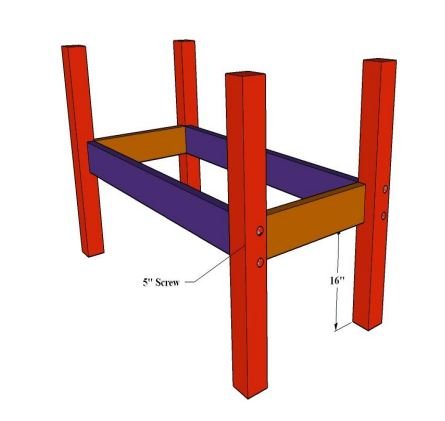
Step 4:
Now we will make the lower part of our planter bed. Here we stick our D1 (2 x 6 x 54'') pieces to the B1 side support pieces, starting from the right or left, and screw them from the outside.
We will do one normal screwing operations on each piece. From the middle of piece D1.
If you want, you can use 2 screws, one from the right and the left, to make it more robust.
Instead, I preferred to make additional screws from the middle of the C1 side support parts.
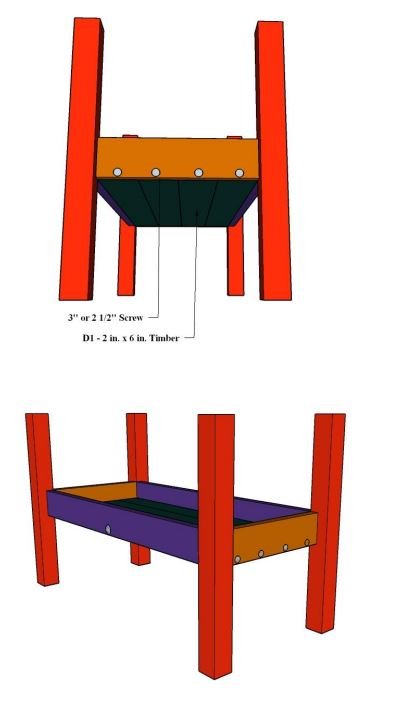
Notes:
It will be easier to stain the raised planter front 2 x 6 boards separately before you finish assembling the raised planter, especially if you use two different stain colors like.
First, sand the wood with 150 grit or higher sandpaper to achieve a smooth, even surface before staining.
Thoroughly remove all dust from the wood by using a vacuum with a hose attachment, then wiping clean with a damp cloth. then wiping clean with a damp cloth.
First apply Pre-Stain Wood Conditioner to the raised planter side 2 x 6 boards.
Apply the Pre-Stain Wood Conditioner and allow it to penetrate the wood for just 1-5 minutes, then remove excess conditioner that has not soaked into the wood with a clean rag Apply Water Based Wood Stain to all of the wood.
You can the color Desert Sand mixed for the side(B1) 2 x 6 boards and the color Pure White mixed for the raised planter legs .
What I love about the water based stain is:
1) how easy clean up is…
2) how little odor the stain has…
3) the colors.
You can get everything from bold, colorful shades to neutral wood tones to light, creamy cottage and ocean-inspired stains.
Apply the stain using a foam brush, and allow it to penetrate the wood no longer than 3 minutes.
It is very fast-drying, so work in small sections! Wipe the wood with a clean cloth to remove any stain that has not soaked into the wood.
Allow the stain to dry 24 hours before applying a protective finish.
Tip: It will be easier to wear a pair of gloves while wiping the excess stain to keep our hands clean than to wash our hands.
After the stain has dried 24 hours, apply a thin coat of Water Based Polycrylic (I used the clear matte finish) using a brush.
Allow to dry at least 2 hours, then sand with a very fine 220 grit sandpaper and remove all dust.
Apply a second and third coat, drying and sanding in between each layer.
The wood will need 3 hours to dry before handling and 24 hours before it will be fully cured.
If you've ever used a polyurethane on top of white paint and saw the yellow stains that appeared once the poly dried, you know how important it is to make sure you're using the right topcoat.
Step 5:
Now we place the B1 pieces on top of the lower B1 piece and drill and screw them using a screw from the back facing parts.
We use 5'' screw.
You should place the screws in the middle of the B1 part and screw them in.

Step 6:
Here, we glue the C1 pieces on the previous ones, then we drill and screw 2 pieces from the top and bottom using 5 inch screws from the right and left ends.
It will be better to screw after each bonding process.
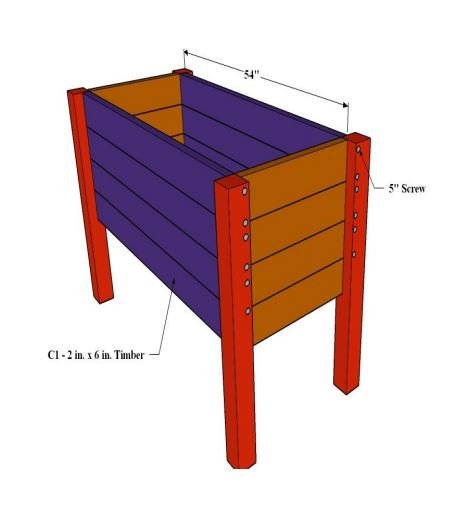
Step 7:
At this stage, we place the E1(2 x 4 x 22'') pieces to the starting line of the feet, align and glue them, then screw them with normal screws from the top.
You can screw in from the right and left. We use 2 1/2" screws.
If you want it to be more robust, you can also use a 3'' screw.
Make sure that the screws correspond to the inside of the E1 parts.

Step 8:
Now we place the F1(2 x 4 x 61'') pieces on the outer parts of the E1 pieces from one end to the other and glue and screw them. We use 2 1/2" or 3" screws.
Make sure that the screws correspond to the outer parts of the F1 parts

We have completed our Project!

A beautiful and simple raised planter box for your outdoor, garden, patio, or balcony.



